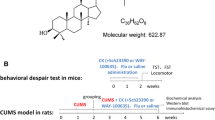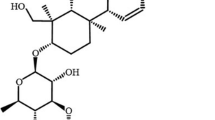Abstract
Previous studies have demonstrated that repeated restraint stress in rodents increased depression-like behavior and altered the expression of corticotrophin-releasing factor in the hypothalamus. The current study focused on verifying the impact of fucoidan (FCN) administration on repeated restraint stress-induced behavioral responses using the forced swimming test (FST). Additionally, we examined the effect of FCN on the central noradrenergic system by observing changes in neuronal tyrosine hydroxylase (TH) immunoreactivity and brain-derived neurotrophic factor (BDNF) mRNA expression in the rat brains. Male rats received 10, 20, or 50 mg/kg FCN (i.p.) 30 min before daily exposures to repeated restraint stress (2 h/day) for 14 days. Repeated restraint stress increased immobility in the FST. Daily administration of FCN during the repeated restraint stress period significantly inhibited the stress-induced behavioral deficits in this behavioral test. Administration of FCN also significantly blocked the increase in TH expression in the locus coeruleus and the basolateral nucleus of the amygdala, and the decrease in BDNF mRNA expression in the hippocampus. Taken together, these findings indicate that administration of FCN prior to restraint stress significantly improved helpless behavior in rats, possibly through modulating the central noradrenergic system. Therefore, FCN may be a useful agent for treating complex symptoms of depression disorder.






Similar content being viewed by others
References
Moussavi S, Chatterji S, Verdes E, Tandon A, Patel V, Ustun B (2007) Depression, chronic diseases, and decrements in health: results from the World Health Surveys. Lancet 370:851–858
Krishnan V, Nestler EJ (2008) The molecular neurobiology of depression. Nature 455:894–902
Kang A, Hao H, Zheng X, Liang Y, Xie Y, Xie T, Dai C, Zhao Q, Wu X, Xie L, Wang G (2011) Peripheral anti-inflammatory effects explain the ginsenosides paradox between poor brain distribution and anti-depression efficacy. J Neuroinflammation 8:100–113
Wong ML, Licinio J (2001) Research and treatment approaches to depression. Nat Rev Neurosci 2:343–351
Colman I, Ataullahjan A (2010) Life course perspectives on the epidemiology of depression. Can J Psychiatry 55:622–632
Uliaszek AA, Zinbarg RE, Mineka S, Craske MG, Sutton JM, Griffith JW, Rose R, Waters A, Hammen C (2010) The role of neuroticism and extraversion in the stress–anxiety and stress–depression relationships. Anxiety Stress Coping 23:363–381
Anisman H, Matheson K (2005) Stress, depression, and anhedonia: caveats concerning animal models. Neurosci Biobehav Revs 29:525–546
Nestler EJ, Barrot M, DiLeone RJ, Eisch AJ, Gold SJ, Monteggia LM (2002) Neurobiology of depression. Neuron 34:13–25
Maccari S, Morley-Fletcher S (2007) Effects of prenatal restraint stress on the hypothalamus–pituitary–adrenal axis and related behavioural and neurobiological alterations. Psychoneuroendocrinology 32:S10–S15 (review)
Tsigos C, Chrousos GP (2002) Hypothalamic–pituitary–adrenal axis, neuroendocrine factors and stress. J Psychosom Res 53:865–871
McLaughlin KJ, Gomez JL, Baran SE, Conrad CD (2007) The effects of chronic stress on hippocampal morphology and function: an evaluation of chronic restraint paradigms. Brain Res 1161:56–64
Vyas A, Mitra R, Shankaranarayana Rao BS, Chattarji S (2002) Chronic stress induces contrasting patterns of dendritic remodeling in hippocampal and amygdaloid neurons. J Neurosci 22:6810–6818
Torres IL, Gamaro GD, Vasconcellos AP, Silveira R, Dalmaz C (2002) Effects of chronic restraint stress on feeding behavior and on monoamine levels in different brain structures in rats. Neurochem Res 27:519–525
Vollmayr B, Faust H, Lewicka S, Henn FA (2001) Brain-derived-neurotrophic-factor (BDNF) stress response in rats bred for learned helplessness. Mol Psychiatry 6:471–474
Bravo JA, Díaz-Veliz G, Mora S, Ulloa JL, Berthoud VM, Morales P, Arancibia S, Fiedler JL (2009) Desipramine prevents stress-induced changes in depressive-like behavior and hippocampal markers of neuroprotection. Behav Pharmacol 20:273–285
O’Mahony CM, Clarke G, Gibney S, Dinan TG, Cryan JF (2011) Strain differences in the neurochemical response to chronic restraint stress in the rat: relevance to depression. Pharmacol Biochem Behav 97:690–699
Sandi C, Merino JJ, Cordero MI, Touyarot K, Venero C (2001) Effects of chronic stress on contextual fear conditioning and the hippocampal expression of the neural cell adhesion molecule, ITS polysialylation and L1. Neuroscience 102:329–339
Gregus A, Wintink AJ, Davis AC, Kalynchuk LE (2005) Effect of repeated corticosterone injections and restraint stress on anxiety and depression-like behavior in male rats. Behav Brain Res 156:105–114
Dazzi L, Seu E, Cherchi G, Biggio G (2005) Chronic administration of the SSRI fluvoxamine markedly and selectively reduces the sensitivity of cortical serotonergic neurons to footshock stress. Eur Neuropsychopharmacol 15:283–290
Smith JM (2010) Clinical implications of treating depressed older adults with SSRIs: possible risk of hyponatremia. J Gerontol Nurs 36:22–27
Liebert R, Gavey N (2009) “There are always two sides to these things”: managing the dilemma of serious adverse effects from SSRIs. Soc Sci Med 68:1882–1891
Deligiannidis KM, Freeman MP (2010) Complementary and alternative medicine for the treatment of depressive disorders in women. Psychiatr Clin N Am 33:441–463
Cumashi A, Ushakova NA, Preobrazhenskaya ME, D’Incecco A, Piccoli A, Totani L, Tinari N, Morozevich GE, Berman AE, Bilan MI, Usov AI, Ustyuzhanina NE, Grachev AA, Sanderson CJ, Kelly M, Rabinovich GA, Iacobelli S, Nifantiev NE, Consorzio Interuniversitario Nazionale per la Bio-Oncologia, Italy (2007) A comparative study of the anti-inflammatory, anticoagulant, antiangiogenic, and antiadhesive activities of nine different fucoidans from brown seaweeds. Glycobiology 17:541–552
Jhamandas JH, Wie MB, Harris K, MacTavish D, Kar S (2005) Fucoidan inhibits cellular and neurotoxic effects of beta amyloid (A beta) in rat cholinergic basal forebrain neurons. Eur J Neurosci 21:2649–2659
Bojakowski K, Abramczyk P, Bojakowska M, Zwolinska A, Przybylski J, Gaciong Z (2001) Fucoidan improves the renal blood flow in the early stage of renal ischemia/reperfusion injury in the rat. J Physiol Pharmacol 52:137–143
Li C, Gao Y, Xing Y, Zhu H, Shen J, Tian J (2011) Fucoidan, a sulfated polysaccharide from brown algae, against myocardial ischemia–reperfusion injury in rats via regulating the inflammation response. Food Chem Toxicol 49:2090–2095
Paxinos G, Watson C (1986) The rat brain in stereotaxic coordinates. Academic Press, New York
Chotiwat C, Harris RB (2008) Antagonism of specific corticotropin-releasing factor receptor subtypes selectively modifies weight loss in restrained rats. Am J Physiol Regul Integr Comp Physiol 295:R1762–R1773
Ling S, Jamali F (2003) Effect of cannulation surgery and restraint stress on the plasma corticosterone concentration in the rat: application of an improved corticosterone HPLC assay. J Pharm Pharm Sci 6:246–251
Vieira C, De Lima TC, Carobrez Ade P, Lino-de-Oliveira C (2008) Frequency of climbing behavior as a predictor of altered motor activity in rat forced swimming test. Neurosci Lett 445:170–173
Cui YQ, Zhang LJ, Zhang T, Luo DZ, Jia YJ, Guo ZX, Zhang QB, Wang X, Wang XM (2010) Inhibitory effect of fucoidan on nitric oxide production in lipopolysaccharide-activated primary microglia. Clin Exp Pharmacol Physiol 37:422–428
Guo JY, Guo JY, Li CY, Ruan YP, Sun M, Qi XL, Zhao BS, Luo F (2009) Chronic treatment with celecoxib reverses chronic unpredictable stress-induced depressive-like behavior via reducing cyclooxygenase-2 expression in rat brain. Eur J Pharmacol 612:54–60
Dantzer R, O’Connor JC, Freund GG, Johnson RW, Kelley KW (2008) From inflammation to sickness and depression: when the immune system subjugates the brain. Nat Rev Neurosci 9:46–56
Loftis JM, Huckans M, Morasco BJ (2010) Neuroimmune mechanisms of cytokine-induced depression: current theories and novel treatment strategies. Neurobiol Dis 37:519–533
Ale MT, Maruyama H, Tamauchi H, Mikkelsen JD, Meyer AS (2011) Fucoidan from Sargassum sp. and Fucus vesiculosus reduces cell viability of lung carcinoma and melanoma cells in vitro and activates natural killer cells in mice in vivo. Int J Biol Macromol 49:331–336
Fan JM, Chen XQ, Jin H, Du JZ (2009) Gestational hypoxia alone or combined with restraint sensitizes the hypothalamic–pituitary–adrenal axis and induces anxiety-like behavior in adult male rat offspring. Neuroscience 10:1363–1373
Suvrathan A, Tomar A, Chattarji S (2010) Effects of chronic and acute stress on rat behaviour in the forced-swim test. Stress 13:533–540
Cryan JF, Holmes A (2005) The ascent of mouse: advances in modelling human depression and anxiety. Nat Rev Drug Discov 4:775–790
Tanaka M, Telegdy G (2008) Involvement of adrenergic and serotonergic receptors in antidepressant-like effect of urocortin 3 in a modified forced swimming test in mice. Brain Res Bull 77:301–305
Chotiwat C, Kelso EW, Harris RB (2010) The effects of repeated restraint stress on energy balance and behavior of mice with selective deletion of CRF receptors. Stress 13:203–213
Ströhle A, Holsboer F (2003) Stress responsive neurohormones in depression and anxiety. Pharmacopsychiatry 3:S207–S214 (review)
MacGillivray L, Reynolds KB, Sickand M, Rosebush PI, Mazurek MF (2011) Inhibition of the serotonin transporter induces microglial activation and downregulation of dopaminergic neurons in the substantia nigra. Synapse 65:1166–1172
Osterhout CA, Sterling CR, Chikaraishi DM, Tank AW (2005) Induction of tyrosine hydroxylase in the locus coeruleus of transgenic mice in response to stress or nicotine treatment: lack of activation of tyrosine hydroxylase promoter activity. J Neurochem 94:731–741
Park HJ, Shim HS, Kim H, Kim KS, Lee H, Hahm DH, Shim I (2010) Effects of glycyrrhizae radix on repeated restraint stress-induced neurochemical and behavioral responses. Korean J Physiol Pharmacol 14:371–376
Oliva JM, Uriguen L, Perez-Rial S, Manzanares J (2005) Time course of opioid and cannabinoid gene transcription alterations induced by repeated administration with fluoxetine in the rat brain. Neuropharmacology 49:618–626
Spasojevic N, Gavrilovic L, Dronjak S (2010) Effects of repeated maprotiline and fluoxetine treatment on gene expression of catecholamine synthesizing enzymes in adrenal medulla of unstressed and stressed rats. Auton Autacoid Pharmacol 30:213–217
Redmond DE Jr, Huang YH (1982) The primate locus coerleus and effects of clonidine on opiate withdrawal. J Clin Psychiatry 43:25–29
Melia KR, Rasmussen RZ, Terwillinger JW, Haycook EJ, Nestler RS (1992) Coordinate regulation of the cyclic AMP system with firing rate and expression of tyrosine hydroxylase the rat locus coeruleus: effects of chronic stress and drug treatment. J Neurochem 58:494–502
Sevgi S, Ozek M, Eroglu L (2003) l-NAME prevents anxiety-like and depression-like behavior in rats exposed to restraint stress. Methods Find Exp Clin Pharmacol 28:95–99
Cirulli F, Berry A, Bonsignore LT, Capone F, D’Andrea I, Aloe L, Branchi I, Alleva E (2010) Early life influences on emotional reactivity: evidence that social enrichment has greater effects than handling on anxiety-like behaviors, neuroendocrine responses to stress and central BDNF levels. Neurosci Biobehav Rev 34:808–820 (review)
Gatt JM, Nemeroff CB, Dobson-Stone C, Paul RH, Bryant RA, Schofield PR, Gordon E, Kemp AH, Williams LM (2009) Interactions between BDNF Val66Met polymorphism and early life stress predict brain and arousal pathways to syndromal depression and anxiety. Mol Psychiatry 14:681–695
Luo D, Zhang Q, Wang H, Cui Y, Sun Z, Yang J, Zheng Y, Jia J, Yu F, Wang X, Wang X (2009) Fucoidan protects against dopaminergic neuron death in vivo and in vitro. Eur J Pharmacol 617:33–40
Do H, Kang NS, Pyo S, Billiar TR, Sohn EH (2011) Differential regulation by fucoidan of IFN-γ-induced NO production in glial cells and macrophages. J Cell Biochem 111:1337–1345
Acknowledgments
This work was supported by a grant from the Kyung Hee University in 2011 (KHU-20110087) and the National Research Foundation of Korea Grant funded by the Korean Government (MEST) (2010-0003678).
Author information
Authors and Affiliations
Corresponding authors
Rights and permissions
About this article
Cite this article
Lee, B., Shim, I., Lee, H. et al. Fucoidan prevents depression-like behavior in rats exposed to repeated restraint stress. J Nat Med 67, 534–544 (2013). https://doi.org/10.1007/s11418-012-0712-5
Received:
Accepted:
Published:
Issue Date:
DOI: https://doi.org/10.1007/s11418-012-0712-5




